











Some time during mid April of 2008 I discovered a Robin's nest in a Bradford Pear Tree in my back yard. I thought it would be interesting to document, through photos and videos, the incubation, hatching and raising of three baby Robins. The following is the result of approximately 3 weeks of documenting the various stages of a baby Robin's life - enjoy!



American robin
Turdus migratorius
Geographic Range
American robins are native to
the Nearctic region. They occur
year-round in southern Canada
from Newfoundland to British
Columbia, throughout most of
the United States and along the
Sierra Madre into southern
Mexico. They migrate south for
the winter, going as far as
southern Mexico and
Guatemala. In summer they are
found as far north as
northernmost Canada and
Alaska. American robins are the
most abundant and widespread
North American thrush.
Habitat
American robins occur mainly in
woodlands, gardens, orchards,
lawns, and fields. They prefer
areas of open ground or short
grass for foraging, with
woodland or a few scattered
trees and shrubs nearby for
nesting and roosting. Suburban
and agricultural areas often
provide these kinds of habitats
so American robins are common
near humans. They need dense
shrubs and small trees in which
to build their nests. They build
nests deep in dense foliage to
protect their young from
predators.
Physical Description
Mass
77 g (average)
(2.71 oz)
Length
23 to 28 cm; avg. 25 cm
(9.06 to 11.02 in; avg. 9.84 in)
Wingspan
119 to 137 mm
(4.69 to 5.39 in)
American robins are birds that
measure 25 cm in length and
average 77 g in weight. Males
are only slightly larger than
females. They are brown on
their backs, reddish on the
breast, and white on their lower
belly and under their tail
feathers. Their throats are white,
streaked with black. They have
white crescents above and
below their eyes. Females are
slightly paler in color than males.
Young American robins have
dark spots on their breasts and
are also paler in color than adult
males.
Reproduction
Males and females form a pair
bond during breeding season
and while raising their young.
American robins breed in the
spring shortly after returning to
their summer range (north) from
their winter range (south). The
breeding season extends from
April through July. American
robins are one of the first birds
to begin laying eggs and
normally have two or three sets
of young, or broods, in each
breeding season. The
cup-shaped nest is built by the
female, who builds the outer
foundation with long coarse
grass, twigs, paper, and
feathers woven together. She
lines the inner bowl with mud,
smearing it with her breast and
later adding fine grass or other
soft material to cushion the
eggs. The nest can be located
on the ground or high up in
trees, but most commonly 5 to
15 feet above ground in a dense
bush, in the crotch of trees, or
on window ledges or other
human structures. All that is
needed for the nest is a firm
support and protection from
rain. A new nest is built to raise
each brood. In northern areas
the first clutch is generally
placed in an evergreen tree or
shrub, and the later clutches are
laid in a deciduous tree. From 3
to 5 eggs are laid in each clutch.
Eggs are incubated by the
female. After about 14 days of
incubation the eggs hatch. She
continues to feed and brood the
chicks while they are very
young. When the nestlings
become older the female broods
them only at night or during bad
weather. Baby birds leave the
nest about 2 weeks after they
have hatched. All babies from a
clutch leave the nest within 1
day of each other. Even after
leaving the nest, the young birds
follow their parents and beg
food from them. They remain
under cover on the ground
during this time. About two
weeks after fledging, young
American robins become
capable of sustained flight.
Lifespan / longevity
One wild bird lived to be almost
14 years old, though most
American robins in the wild will
live about 2 years. Only about
one quarter of all young
American robins will survive the
summer in which they were born.
Behavior
American robins are active
mostly during the day. They are
social birds, especially during
the winter when they are
gathered in large numbers on
their winter grounds. They
assemble in large flocks at night,
often in a secluded swamp or
area of dense vegetation, where
they roost in the trees. These
winter aggregations break up
during the day to feed in smaller
flocks on fruits and berries.
American robins defend
breeding territories during the
summer and are less social
during that time. Young
American robins remain in the
area of their nest for their first 4
months of life. They gather in
mixed-age flocks when it
becomes time to depart for their
winter grounds. Almost all
populations of American robins
are migratory.
Communication and
Perception
Soon after hatching nestlings
begin to beg for food by
chirping. Adult American robins
use chirping or chucking to warn
of the presence of a predator.
Males begin to sing in the late
winter and early spring. This
song is a familiar sound in the
springtime and sounds
something like 'cheerily, cheer
up, cheer up, cheerily, cheer
up.' American robins sing
frequently throughout the day,
but particularly early in the
morning. They most often sing
from a perching spot high in a
tree.
Food Habits
American Robins feed on a
mixture of both wild and
cultivated fruits, berries,
earthworms, and insects such as
beetle grubs, caterpillars, and
grasshoppers. Robins are
flexible and will turn to whichever
food is most readily accessible,
although the diet generally
consists of approximately 40%
invertebrates, 60% fruits and
berries.
Predation
American robins may mob small
predators, such as blue jays and
snakes. They also produce
chirping and chucking sounds
as warning calls.
Predators on young and adults
differ somewhat. Eggs and
young are often eaten by
different types of squirrels,
snakes, and birds such as blue
jays, common grackles,
American crows, and common
ravens. Adult American robins
are preyed upon by hawks, cats,
and larger snakes.
American robins are vigilant
when feeding, they may feed in
loose flocks, so that they can
also watch other robins for
reactions to predators.
Ecosystem Roles
American robins are important
as prey items to their predators
because there are so many of
them. They also act to control
some insect populations and to
disperse the seeds of the fruits
they eat.
Conservation Status
American robins are successful
birds, having been able to adapt
to human alteration of the
landscape. At one time, they
were killed for meat in some
southern States, and the meat
was considered a delicacy. They
are now protected throughout
their range by the U.S. Migratory
Bird Protection Act.
Source
Turdus migratorius
Geographic Range
American robins are native to
the Nearctic region. They occur
year-round in southern Canada
from Newfoundland to British
Columbia, throughout most of
the United States and along the
Sierra Madre into southern
Mexico. They migrate south for
the winter, going as far as
southern Mexico and
Guatemala. In summer they are
found as far north as
northernmost Canada and
Alaska. American robins are the
most abundant and widespread
North American thrush.
Habitat
American robins occur mainly in
woodlands, gardens, orchards,
lawns, and fields. They prefer
areas of open ground or short
grass for foraging, with
woodland or a few scattered
trees and shrubs nearby for
nesting and roosting. Suburban
and agricultural areas often
provide these kinds of habitats
so American robins are common
near humans. They need dense
shrubs and small trees in which
to build their nests. They build
nests deep in dense foliage to
protect their young from
predators.
Physical Description
Mass
77 g (average)
(2.71 oz)
Length
23 to 28 cm; avg. 25 cm
(9.06 to 11.02 in; avg. 9.84 in)
Wingspan
119 to 137 mm
(4.69 to 5.39 in)
American robins are birds that
measure 25 cm in length and
average 77 g in weight. Males
are only slightly larger than
females. They are brown on
their backs, reddish on the
breast, and white on their lower
belly and under their tail
feathers. Their throats are white,
streaked with black. They have
white crescents above and
below their eyes. Females are
slightly paler in color than males.
Young American robins have
dark spots on their breasts and
are also paler in color than adult
males.
Reproduction
Males and females form a pair
bond during breeding season
and while raising their young.
American robins breed in the
spring shortly after returning to
their summer range (north) from
their winter range (south). The
breeding season extends from
April through July. American
robins are one of the first birds
to begin laying eggs and
normally have two or three sets
of young, or broods, in each
breeding season. The
cup-shaped nest is built by the
female, who builds the outer
foundation with long coarse
grass, twigs, paper, and
feathers woven together. She
lines the inner bowl with mud,
smearing it with her breast and
later adding fine grass or other
soft material to cushion the
eggs. The nest can be located
on the ground or high up in
trees, but most commonly 5 to
15 feet above ground in a dense
bush, in the crotch of trees, or
on window ledges or other
human structures. All that is
needed for the nest is a firm
support and protection from
rain. A new nest is built to raise
each brood. In northern areas
the first clutch is generally
placed in an evergreen tree or
shrub, and the later clutches are
laid in a deciduous tree. From 3
to 5 eggs are laid in each clutch.
Eggs are incubated by the
female. After about 14 days of
incubation the eggs hatch. She
continues to feed and brood the
chicks while they are very
young. When the nestlings
become older the female broods
them only at night or during bad
weather. Baby birds leave the
nest about 2 weeks after they
have hatched. All babies from a
clutch leave the nest within 1
day of each other. Even after
leaving the nest, the young birds
follow their parents and beg
food from them. They remain
under cover on the ground
during this time. About two
weeks after fledging, young
American robins become
capable of sustained flight.
Lifespan / longevity
One wild bird lived to be almost
14 years old, though most
American robins in the wild will
live about 2 years. Only about
one quarter of all young
American robins will survive the
summer in which they were born.
Behavior
American robins are active
mostly during the day. They are
social birds, especially during
the winter when they are
gathered in large numbers on
their winter grounds. They
assemble in large flocks at night,
often in a secluded swamp or
area of dense vegetation, where
they roost in the trees. These
winter aggregations break up
during the day to feed in smaller
flocks on fruits and berries.
American robins defend
breeding territories during the
summer and are less social
during that time. Young
American robins remain in the
area of their nest for their first 4
months of life. They gather in
mixed-age flocks when it
becomes time to depart for their
winter grounds. Almost all
populations of American robins
are migratory.
Communication and
Perception
Soon after hatching nestlings
begin to beg for food by
chirping. Adult American robins
use chirping or chucking to warn
of the presence of a predator.
Males begin to sing in the late
winter and early spring. This
song is a familiar sound in the
springtime and sounds
something like 'cheerily, cheer
up, cheer up, cheerily, cheer
up.' American robins sing
frequently throughout the day,
but particularly early in the
morning. They most often sing
from a perching spot high in a
tree.
Food Habits
American Robins feed on a
mixture of both wild and
cultivated fruits, berries,
earthworms, and insects such as
beetle grubs, caterpillars, and
grasshoppers. Robins are
flexible and will turn to whichever
food is most readily accessible,
although the diet generally
consists of approximately 40%
invertebrates, 60% fruits and
berries.
Predation
American robins may mob small
predators, such as blue jays and
snakes. They also produce
chirping and chucking sounds
as warning calls.
Predators on young and adults
differ somewhat. Eggs and
young are often eaten by
different types of squirrels,
snakes, and birds such as blue
jays, common grackles,
American crows, and common
ravens. Adult American robins
are preyed upon by hawks, cats,
and larger snakes.
American robins are vigilant
when feeding, they may feed in
loose flocks, so that they can
also watch other robins for
reactions to predators.
Ecosystem Roles
American robins are important
as prey items to their predators
because there are so many of
them. They also act to control
some insect populations and to
disperse the seeds of the fruits
they eat.
Conservation Status
American robins are successful
birds, having been able to adapt
to human alteration of the
landscape. At one time, they
were killed for meat in some
southern States, and the meat
was considered a delicacy. They
are now protected throughout
their range by the U.S. Migratory
Bird Protection Act.
Source

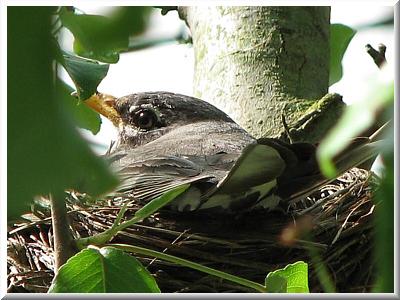
April 22, 2008: Momma Robin on the nest.
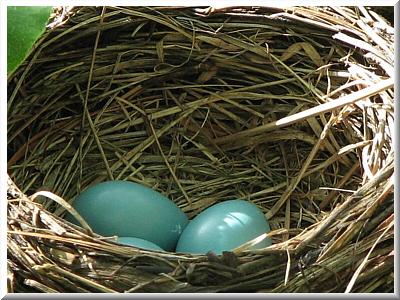
April 22, 2008: First look at the eggs.
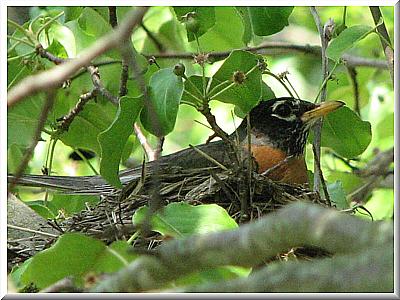
April 26, 2008: Momma Robin appears to be sitting a little higher in the nest this morning.
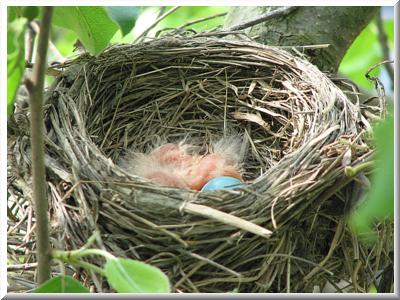
April 26, 2008: I'm not sure if this is one baby or two. At this angle, I can only see one egg.
VIDEO: April 27, 2008: All of the eggs hatched last night or this morning. Here is a short clip of momma feeding her babies and cleaning her nest.
VIDEO: April 30, 2008: The baby Robins are really growing.
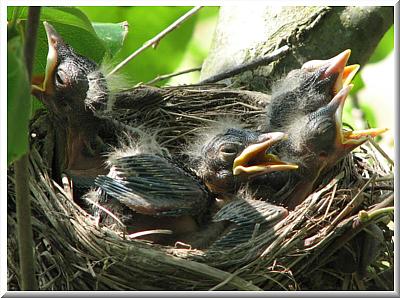
May 02, 2008: Hey wait a minute! Where did this fourth little fella come from?
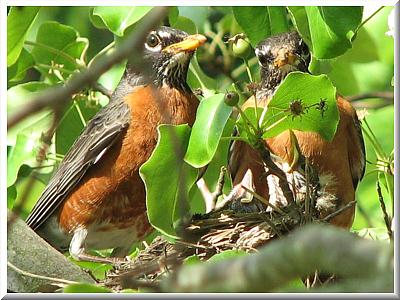
May 04, 2008: Both parents hard at work providing for their babies.
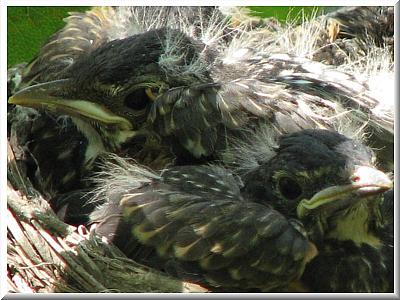
May 06, 2008: It won't be much longer, these babies will be all on their own.
VIDEO: May 06, 2008: Both parents seen feeding the young.
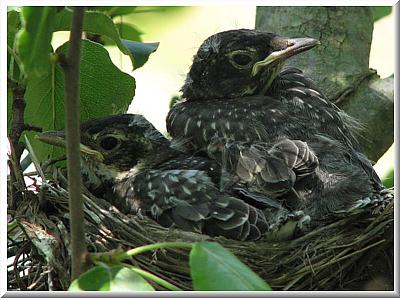
May 07, 2008: Is it my imagination, or is that nest getting smaller?
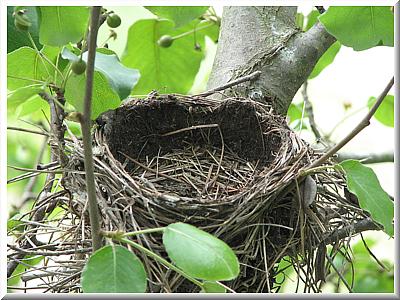
May 12, 2008: Sometime during the weekend of 05/10/08 - 05/11/08, the babies left the nest.